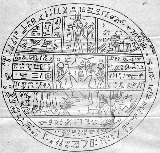
Joseph Smith Hypocephalus
Encyclopedia
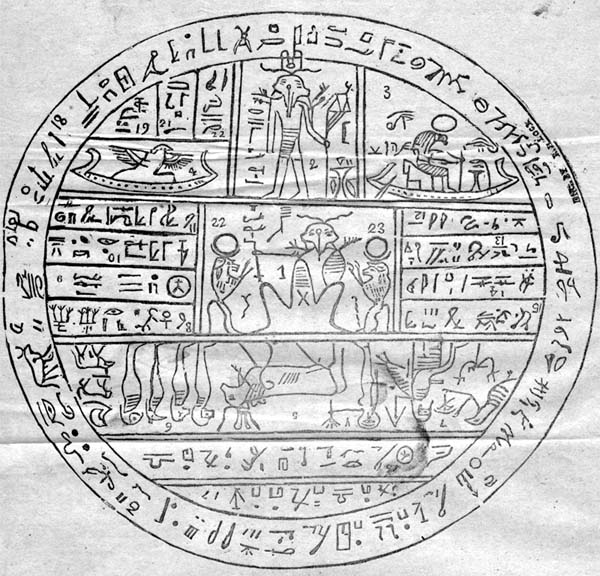
Hypocephalus
A hypocephalus is a small disk-shaped object generally made of stuccoed linen, but also of papyrus, bronze, gold, wood, or clay, which ancient Egyptians from the Late Period on placed under the heads of their dead. It was believed to magically protect the deceased, cause the head and body to be...
or Hypocephalus of Sheshonq, was found in the Gurneh area of Thebes, Egypt
Thebes, Egypt
Thebes is the Greek name for a city in Ancient Egypt located about 800 km south of the Mediterranean, on the east bank of the river Nile within the modern city of Luxor. The Theban Necropolis is situated nearby on the west bank of the Nile.-History:...
around the year 1818. From translation of the text, its owner's name was Sheshonq. Three hypocephali in the British Museum
British Museum
The British Museum is a museum of human history and culture in London. Its collections, which number more than seven million objects, are amongst the largest and most comprehensive in the world and originate from all continents, illustrating and documenting the story of human culture from its...
(37909, 8445c, and 8445f) are similar to the Joseph Smith Hypocephalus both in layout and text and were also found in Thebes. A woodcut image of the hypocephalus was initially published on March 15, 1842 in Volume III, No. 10 of the Latter Day Saint newspaper Times and Seasons
Times and Seasons
Times and Seasons was a 19th-century Latter Day Saint periodical published monthly or twice-monthly at Nauvoo, Illinois, from November 1839 to February 15, 1846...
.
As with other hypocephali, the complete image represents the Eye of Shu
Shu (Egyptian deity)
In Egyptian mythology, Shu is one of the primordial gods, a personification of air, one of the Ennead of Heliopolis. He was created by Atum, his father and Iusaaset, his mother in the city of Heliopolis. With his sister, Tefnut , he was the father of Nut and Geb...
, the Eye of Ra, or the Eye of Horus
Eye of Horus
The Eye of Horus is an ancient Egyptian symbol of protection, royal power and good health. The eye is personified in the goddess Wadjet...
, and was part of the burial materials created by Egyptians from the XXVIth dynasty onward.
Ra
Ra
Ra is the ancient Egyptian sun god. By the Fifth Dynasty he had become a major deity in ancient Egyptian religion, identified primarily with the mid-day sun...
was Egypt's most important deity and has expression in multiple forms, acting in the heavens, on earth, in the underworld, as the creator and as father to the king, but always associated with the sun. Ra's primary icon was the fiery disk of the sun, usually encircled by a protective cobra (ureaus) and often with outstreatched wings or rays. Anthropomorphically, Ra was expressed as a man with the head of a falcon, ram or scarab. He was also depicted as a falcon wearing the sun's disk, or as a ram, scarab beetle, phoenix, heron, serpent, bull, cat, lion or flying vulture. His three primary expressions were the morning sun as a scarab beetle, the noon day sun as the solar disk, and the setting sun as a ram headed man.
Within the circular image are compartments containing hieroglyphic text and figures which are typically extracts from Chapter CLXII of the Egyptian Book of the Dead
Book of the Dead
The Book of the Dead is the modern name of an ancient Egyptian funerary text, used from the beginning of the New Kingdom to around 50 BC. The original Egyptian name for the text, transliterated rw nw prt m hrw is translated as "Book of Coming Forth by Day". Another translation would be "Book of...
. P. J. de Horrack stated that the scenes portrayed in hypocephali relate in all their details to the resurrection and the renewed birth after death...symbolized by the course of the Sun, the living image of divine generation. The circle is divided to represent two celestial hemispheres and the cycle of renewal.
There is still some ambiguity regarding how these Egyptian names and text may have been pronounced.
The numbers labeling the figures were added to correspond to explanations of the images and text given by Joseph Smith
Joseph Smith
Joseph Smith was founder of what later became known as the Latter Day Saint movement or Mormons.Joseph Smith may also refer to:-Latter Day Saints:* Joseph Smith, Sr. , father of Joseph Smith...
.
Figures No. 1, 22 and 23
 |
The central figure wears the undulating horns of the Ovis longpipes ram, which is symbolic of Khnum, the first creator god. Khnum was the potter who molded the souls and bodies of all living things from the clay of the earth, and gave them the breath of life. He was described as the "ba" (spiritual force) of Re, The head of the figure is atypically offset to the right. The crouching body is a typical hieroglyphic pose for the god. | The characters above and to the left of the head are three ripples of water, a pennant and a single diagonal stroke. Kerry Shirts identified these three symbols together as the name of Khnum-Ra. Triple ripples (mw) indicate a mass of water. Similar to the double ripples of (nn) Nun, the "Primeval Waters" or state of being before creation. Described in An's mythological cycle as "the waters," Nun lay inert, unending and indefinite, until Tem "rises" and "throws off" the waters to begin the act of creation. Nun is a "primordial soup" from which the Self-Created god drew the materials to create its children Shu Shu Shu may refer to:*Shū ** , Japanese Kanji.*Shu * 蜀 , an abbreviation of Sichuan province of the People's Republic of China, as well as the following historical regimes that have existed in this region:... and Tefnut Tefnut In Ancient Egyptian religion, Tefnut, transliterated tfnt is a goddess of moisture, moist air, dew and rain. She is the sister and consort of the air god Shu and the mother of Geb and Nut.- Etymology :... (air and moisture, the Biblical "firmament"), Who then created Geb Geb Geb was the Egyptian god of the Earth and a member of the Ennead of Heliopolis. It was believed in ancient Egypt that Geb's laughter was earthquakes and that he allowed crops to grow. The name was pronounced as such from the Greek period onward,... (earth) and Nut Nut (goddess) In the Ennead of Egyptian mythology, Nut was the goddess of the sky.-Goddess of the sky:... (sky). An ideographic reading of these symbols would be; The spirit of god rippling the waters. |
Left of center is the was scepter, or DJAM scepter, which are symbols of serenity or strength. | To the left, above the scepter, are characters that may be irrigated land, force or effort, and one cubit. |
On either side are baboons (22 and 23) with upraised arms, wearing the lunar disk headdress, representing the god Thoth Thoth Thoth was considered one of the more important deities of the Egyptian pantheon. In art, he was often depicted as a man with the head of an ibis or a baboon, animals sacred to him. His feminine counterpart was Seshat... or Djehuty. He was often placed opposite Re as a kind of "night sun" and was associated with truth and integrity, regulating time, record keeping and possession of secret knowledge. Thoth provided Isis Isis Isis or in original more likely Aset is a goddess in Ancient Egyptian religious beliefs, whose worship spread throughout the Greco-Roman world. She was worshipped as the ideal mother and wife as well as the matron of nature and magic... with the word formula she needed to resurrect Osiris Osiris Osiris is an Egyptian god, usually identified as the god of the afterlife, the underworld and the dead. He is classically depicted as a green-skinned man with a pharaoh's beard, partially mummy-wrapped at the legs, wearing a distinctive crown with two large ostrich feathers at either side, and... . |
Adjacent to the baboons are two snakes. The primeval serpent "Iru-to" which also represents the creator of the earth. In the Pyramid Texts 1146 Iru-to says; "I am the scribe of the Divine Book which says what has been and effect what is yet to be. | Joseph Smith explained this figure as; "Kolob, signifying the first creation, nearest to the celestial, or the residence of God. First in government, the last pertaining to the measurement of time. The measurement according to celestial time, which celestial time signifies one day to a cubit. One day in Kolob is equal to a thousand years according to the measurement of this earth, which is called by the Egyptians Jah-oh-eh." |
|---|
Figure No. 2
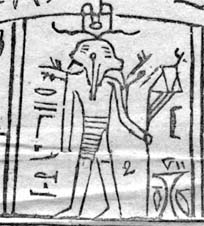 |
The standing figure has a double ram's head with undulating horns and wears the double crown, symbolic of Amun Amun Amun, reconstructed Egyptian Yamānu , was a god in Egyptian mythology who in the form of Amun-Ra became the focus of the most complex system of theology in Ancient Egypt... , god of creation. On his shoulders are jackal heads. In his left hand is the staff of Wepwawet Wepwawet In late Egyptian mythology, Wepwawet was originally a war deity, whose cult centre was Asyut in Upper Egypt . His name means, opener of the ways... and to the right is an offering stand. Plutarch Plutarch Plutarch then named, on his becoming a Roman citizen, Lucius Mestrius Plutarchus , c. 46 – 120 AD, was a Greek historian, biographer, essayist, and Middle Platonist known primarily for his Parallel Lives and Moralia... quoted Manetho Manetho Manetho was an Egyptian historian and priest from Sebennytos who lived during the Ptolemaic era, approximately during the 3rd century BC. Manetho wrote the Aegyptiaca... as saying that Amun Amun Amun, reconstructed Egyptian Yamānu , was a god in Egyptian mythology who in the form of Amun-Ra became the focus of the most complex system of theology in Ancient Egypt... meant "that which is concealed. Amun spoke his own name and brought forth the land of Egypt from the primordial sea (nun). In ancient Egypt it was believed that the gods had a secret name. Knowledge of this name gave others power over them. This figure is very similar to one in the same position on the Hypocephalus of Tashenkhons. with the exception of lacking the ankh Ankh The ankh , also known as key of life, the key of the Nile or crux ansata, was the ancient Egyptian hieroglyphic character that read "eternal life", a triliteral sign for the consonants ʻ-n-ḫ... symbol, orientation of the figure and the associated text. Michael D. Rhodes Michael D. Rhodes Michael Dennis Rhodes is an associate professor of ancient scripture at Brigham Young University . Rhodes is an Egyptologist who has published a translation of some of the extant Joseph Smith papyri.... identified the hieroglypics to the left as; "The name of this Mighty God." This reading identifies/represents the name of the god without actually writing it, similar to the use of YHWH in Hebrew texts. |
Joseph Smith stated that this figure; "Stands next to Kolob Kolob Kolob is a star or planet described in Mormon scripture. Reference to Kolob is found in the Book of Abraham, a work published by Latter Day Saint prophet Joseph Smith, Jr. According to this work, Kolob is the heavenly body nearest to the throne or residence of God... , called by the Egyptians Oliblish, which is the next grand governing creation near to the celestial or the place where God resides; holding the key of power also, pertaining to other planets; as revealed from God to Abraham, as he offered sacrifice upon an altar, which he had built unto the Lord." |
|---|
Figure No. 3
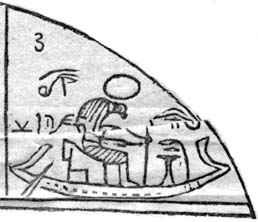 |
A solar barque carries the seated falcon headed Horus Horus Horus is one of the oldest and most significant deities in the Ancient Egyptian religion, who was worshipped from at least the late Predynastic period through to Greco-Roman times. Different forms of Horus are recorded in history and these are treated as distinct gods by Egyptologists... , holding a scepter. The solar disk is over his head. A divine Eye of Ra is on either side. Also on the barque is an offering stand. On some hypocephali the characters to the left are In the religious tradition of ancient Heliopolis, Ra emerged from the petals of a lotus blossom which re-enfolded him each night. The lotus was also a symbol of rebirth associated with Osiris. The Book of the Dead Book of the Dead The Book of the Dead is the modern name of an ancient Egyptian funerary text, used from the beginning of the New Kingdom to around 50 BC. The original Egyptian name for the text, transliterated rw nw prt m hrw is translated as "Book of Coming Forth by Day". Another translation would be "Book of... contains spells for "transforming oneself into a lotus", fulfilling the promise of resurrection. According to the Pyramid Texts Pyramid Texts The Pyramid Texts are a collection of ancient Egyptian religious texts from the time of the Old Kingdom. The pyramid texts are possibly the oldest known religious texts in the world. Written in Old Egyptian, the pyramid texts were carved on the walls and sarcophagi of the pyramids at Saqqara during... the snake Iru-to was the scribe of the Divine Book which said what has been and effects what is yet to be. |
|---|
Figure No. 4
 |
A falcon, representing Horus Horus Horus is one of the oldest and most significant deities in the Ancient Egyptian religion, who was worshipped from at least the late Predynastic period through to Greco-Roman times. Different forms of Horus are recorded in history and these are treated as distinct gods by Egyptologists... , 'lord of the sky', sitting on a mummy case, with outstreatched wings, sitting upon a papyrus boat. This image is similar to the one in the same panel from the hypocephalus of Tashenkhons, with the exception of the rudder and text. |
|---|
Figure No. 5
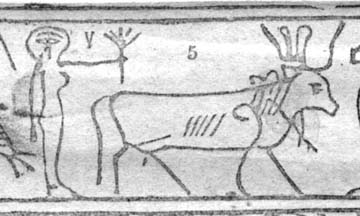 |
A cow, representing Hathor, who was the goddess of the sky, home of the great falcon. Behind is a standing female figure with the Eye of Ra depicted on her head and holding out a papyrus stem in her left hand. This image is similar to the one in the same panel from the hypocephalus of Tashenkhons,. |
|---|
Figure No. 6
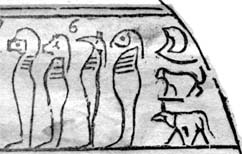 |
Four standing mummiform figures, representing the four sons of Horus Horus Horus is one of the oldest and most significant deities in the Ancient Egyptian religion, who was worshipped from at least the late Predynastic period through to Greco-Roman times. Different forms of Horus are recorded in history and these are treated as distinct gods by Egyptologists... (left to right); Imsety, Hapy Hapy Hapi, sometimes transliterated as Hapy, not to be confused with another god of the same name, was a deification of the annual flooding of the Nile River in Ancient Egyptian religion, which deposited rich silt on its banks, allowing the Egyptians to grow crops. His name means Running One, probably... , Duamutef Duamutef Duamutef was one of the Four Sons of Horus and a protectiongod of the Canopic jars. Commonly he is said to be the son of the god Horus the Elder and the goddess Isis. There is another myth that describes... and Qebesenuef, with the heads of a human, baboon, jackal, and falcon, who were associated with the south, north, east and west. They were the patron gods of the liver, lungs, stomach and intestines of the deceased and were protected by Isis Isis Isis or in original more likely Aset is a goddess in Ancient Egyptian religious beliefs, whose worship spread throughout the Greco-Roman world. She was worshipped as the ideal mother and wife as well as the matron of nature and magic... , Nephthys Nephthys In Egyptian mythology, Nephthys is a member of the Great Ennead of Heliopolis, a daughter of Nut and Geb. Nephthys was typically paired with her sister Isis in funerary rites because of their role as protectors of the mummy and the god Osiris and as the sister-wife of Seth.Nephthys is regarded as... , Neith Neith In Egyptian mythology, Neith was an early goddess in the Egyptian pantheon. She was the patron deity of Sais, where her cult was centered in the Western Nile Delta of Egypt and attested as early as the First Dynasty... and Serket Serket In Egyptian mythology, Serket is the goddess of healing stings and bites who originally was the deification of the scorpion.... . The figures behind them are typically a lotus stem (h3), lion and ram. |
|---|
Figure No. 7
| A seated figure with the tail of a falcon, symbolic of the supreme celestial deity, with a human head and a pharonic beard. This figure has been identified with Min Min Min may refer to:*Min , an Egyptian fertility god*Min , a modern working copy of an Ancient Egyptian ship of Hatshepsut's time*Min , a South Korean celebrity most popularly known as a member of miss A*Min *Min River... , a predynastic god who was usually depicted as a mummy wrapped ithyphallic man with his legs bound together, wearing a twin plumed crown with long streamers and with his arm raised to the square, a gesture identified as the Sign of Preservation. Behind his head is an inverted V. A right angle projects to the right of the shoulder. To the left is a figure with a bird's head, presenting the Eye of Ra. In the hypocephalus of Tashenkhons, the figure on the left is Nehebu-Kau, whose name meant "he who harnesses the spirits" and the inverted V is a flail Flail A flail is an agricultural implement for threshing.Several tools operate similarly to the agricultural implement and are also called flails:... , symbolic of provenance. |
|---|
Figure No. 8
 |
"Grant that the Ba of Osiris Sheshonq live." |
|---|
Figure No. 9
 |
"and below the earth and of the waters" (Damaged in the original.) |
|---|
Figure No. 10
 |
"of the beginning. Great God, Lord of Heaven and earth," |
|---|
Figure No. 11
 |
"O god, sleeping in the time" |
|---|
Figure No. 12
 |
The right portion of these characters are hieratic and appear to have been copied from Joseph Smith Papyrus XI. |
|---|
Figure No. 13
 |
The right portion of these characters are hieratic and appear to have been copied from Joseph Smith Papyrus XI. |
|---|
Figure No. 14
 |
The furthest right character is hieratic and appears to have been copied from Joseph Smith Papyrus XI. Included is sn-sn. |
|---|
Figure No. 15
 |
The left portion of these characters are hieratic and appear to have been copied from Joseph Smith Papyrus XI. |
|---|
Figure No. 16
 |
"is not to be disturbed along with its Lord in the Duat forever." |
|---|
Figure No. 17
 |
(h3t)tomb. (thy)desecration. (nn) strong negative. |
|---|
Figure No. 18 (Rim)
| One third of the rim contains characters taken from another papyrus. Michael D. Rhodes Michael D. Rhodes Michael Dennis Rhodes is an associate professor of ancient scripture at Brigham Young University . Rhodes is an Egyptologist who has published a translation of some of the extant Joseph Smith papyri.... provided a possible reading of the text in its original state: "I am the Provider in the Sun Temple in Heliopolis. [I am] most exalted and very glorious. [I am] a virile bull without equal. [I am] that Mighty God in the Sun Temple in Heliopolis. |
|---|
Figure No. 19
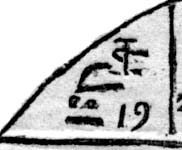 |
"in(of) Busiris" |
|---|
Figure No. 21
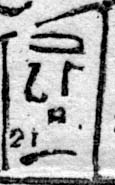 |
"as this god of thine" |
|---|
Figure No. 22
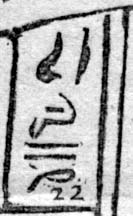 |
"Behold thou art ever" |
|---|

